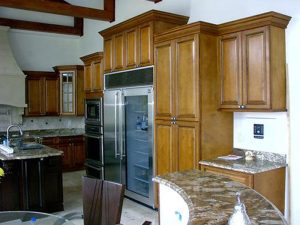Kitchen Remodeling Dallas is any effort to change and improve a home’s kitchen area. It can include everything from replacing flooring to adding a new island.

A fresh new design should not only look good but also work well for your family’s needs. This means ensuring proper clearances between appliances or cabinets and making sure the kitchen has enough storage solutions like shelving or walk-in pantries.
Unlike new construction, which often prioritizes cookie-cutter layouts that can look great but won’t necessarily work well for homeowners’ specific needs, kitchen remodels can be customized to fit each homeowner’s lifestyle. During the design process, we ask questions to determine how each family uses their kitchen and use our experience to create a layout that will be both functional and aesthetically pleasing. This allows for the selection of materials and finishes that will suit each family’s preferences while staying within a budget. Simple tricks like using butcher block or laminate for countertops rather than a more expensive material, painting cabinets instead of replacing them, and swapping out a backsplash for a more affordable one can all save money on kitchen remodeling projects without sacrificing style.
Whether they’re tripping over old linoleum or struggling to make room for everything their growing families need, many homeowners find themselves stuck in a kitchen style rut. Replacing outdated appliances, lightening the color palette, adding a custom range hood, or reworking cabinetry can all breathe new life into a tired kitchen.
The most crucial phase of a kitchen remodel is planning, which includes conceptualizing the design, estimating costs and creating a timeline for project completion. It’s important to take into account the time needed for ordering materials, the lead times for delivery and installation, and any potential issues that may delay progress.
Once the design is complete, it’s time to get to work. The demolition stage removes existing fixtures, trim and flooring to prepare the space for new installations. Once the foundation is in place, you can begin building your dream kitchen.
Increased Value
Kitchen remodels have one of the highest returns on investment for home improvement projects. In addition to enhancing the quality of life within the home, they can help boost resale value. Modern, updated kitchens are often top of the list for prospective homebuyers and can help speed up the sales process.
Depending on the scope of the project, kitchen remodeling can increase home value by between $20,000 and $80,00 or more. The key is to ensure that the scale and cost of the remodel aligns with the home’s current value and the norms of the neighborhood. For example, a high-end kitchen upgrade may not make sense in an average neighborhood where buyers are looking for more modest finishes.
It’s also important to consider sustainability and energy efficiency during the remodel. Installing green features like energy-efficient appliances and LED lighting can help reduce utility costs and your environmental footprint. Choosing sustainable materials like hardwood floors, quartz countertops, and custom cabinetry will also contribute to the value of your home.
If you’re considering a kitchen remodel, it’s important to work with a team of experienced professionals that can handle all the details. From planning and budgeting to demolition and construction, a professional can ensure that the finished product is safe and meets all building codes. They can also help you find ways to save on the project’s overall cost by using money-saving techniques like refacing cabinets, painting instead of replacing them, using inexpensive countertop material, and more. This way, you can get the kitchen of your dreams without going over budget. For more information, contact a local remodeling company. They can provide you with a free estimate and consultation.
Better Cooking Experience
If you’re constantly tripping over old cabinets, struggling to fit your pots and pans, or avoiding having family meals together because of a cramped kitchen, it may be time for a kitchen home improvement project. Remodeling your kitchen can transform this central and bustling room into a functional space that aligns with your unique style and enhances daily life.
Start by defining your goals. For example, are you considering a major renovation to improve function and flow or a minor refresh to update surfaces and fixtures? Once you have a clear idea of what you want to achieve, work with a qualified contractor to establish a realistic budget and timeline with backup plans for potential setbacks.
Before you begin the remodeling process, it’s also important to decide whether you plan to stay in your home during the construction phase. If you do, make sure to ask friends or family members with a spare bedroom for accommodations. If you’re able to get out of your house during the bulk of the remodel, it can help reduce the stress and annoyance that comes with living in an incomplete kitchen.
Designing and choosing a layout is an essential part of kitchen remodeling. To improve functionality, make sure to group like areas together, such as the sink, stovetop, and refrigerator. This creates a “work triangle,” which makes it easier to move around the kitchen while cooking or cleaning. Also, consider how many cooks typically use your kitchen at one time. This will help determine how much storage and workspace is needed. For instance, you may want to have enough room to stow away extra cookware and supplies, or make sure tall stock pots can be stored comfortably.
Healthier Eating Habits
Many homeowners who undergo kitchen remodeling find that they are inspired to cook more often. As a result, they find that cooking at home becomes more enjoyable, and they are able to save money by cutting back on restaurant bills. This is good for the budget, and it also supports healthy eating habits by promoting family mealtimes.
A cramped kitchen can make cooking feel like a chore, and outdated appliances waste energy. A new kitchen design can open up the space, allowing you to move around more easily and increase storage options to reduce clutter. This can help you organize your space more efficiently, so that you can spend less time looking for items and more time preparing meals.
Kitchen remodels can involve a lot of work, but it’s worth it in the long run. Prospective homebuyers prioritize homes with updated kitchens, so a well-designed and modernized kitchen can significantly boost your home’s value. You’ll also enjoy the benefits of a functional and comfortable kitchen that will inspire you to entertain guests and socialize with loved ones.
There are many signs that your kitchen is in need of a remodel, from cluttered surfaces to outdated appliances. A poorly designed kitchen makes it difficult to navigate the area, and outdated materials can detract from your overall aesthetic. A professional kitchen remodeling company, such as Seacoast Cabinet, can offer you a range of solutions that will allow you to update the room without breaking your budget. By working with a team of professionals, you can ensure that your new kitchen will meet all your family’s needs. You can also ask for features such as universal design and adaptable floorplans, which will serve your family well as you grow.
Increased Utility
One of the primary benefits of a kitchen remodel is its improved functionality. Professional designers create smart layouts that maximize space and enhance workflow. By incorporating features like a large sink, plenty of counter space and a functional kitchen island, you will be able to cook and entertain with ease. This enhanced functionality not only makes your home a more pleasant place to live but can also add value by appealing to prospective buyers who prioritize practicality.
Additionally, a kitchen remodel can help you save on energy costs. By replacing old appliances with new energy-efficient models, you can significantly reduce your energy consumption and minimize your carbon footprint. Energy-efficient appliances and fixtures are also often preferred by potential homebuyers, so this can be an important factor when it comes time to sell your home.
Another benefit of a kitchen remodel is its ability to help you stay organized. By incorporating custom cabinets and other innovative storage solutions, you can ensure that all of your kitchen’s essentials have a proper home. This will keep your space clutter-free and ensure that you always know where to find items like your favorite cooking utensils, cutting boards or tea diffuser.
Kitchen remodeling is a significant investment, but it can yield one of the highest returns on your investment when it comes to home improvements. A well-executed kitchen remodel can dramatically increase your home’s resale value, making it a great long-term financial investment. However, it is important to consider the scope and cost of your remodel in relation to your home’s current value and the norms of your neighborhood before proceeding. It is also a good idea to hire professional contractors that are familiar with building codes and safety standards.


